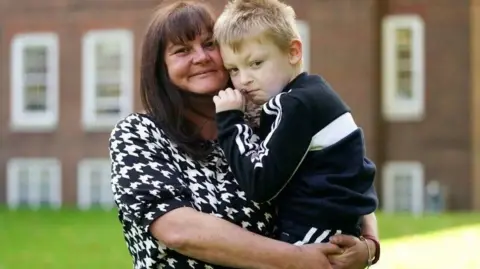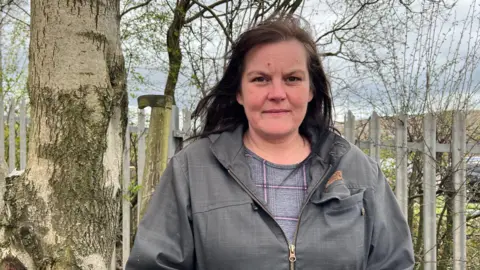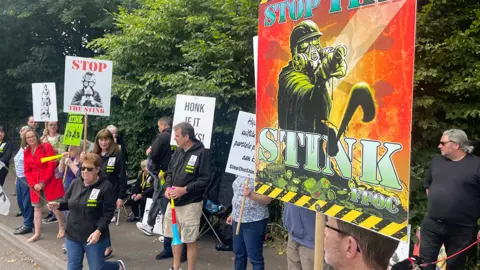Judicial review into handling of landfill emissions
 PA Media
PA MediaA woman who says fumes from a landfill site near her home have shortened the life of her young son has been given permission to pursue legal action against the regulator.
Rebecca Currie said she had successfully applied for a judicial review into the Environment Agency's (EA) handling of the Walleys Quarry site in Silverdale, Staffordshire.
The organisation served a closure notice on the site in November, which had been at the centre of numerous protests and legal action over its impact on local residents.
A spokesperson for the EA said they were unable to comment on ongoing legal proceedings.
Ms Currie previously began legal action in August 2021 over the matter but ran into a dead end after an appeal at The Supreme Court, after earlier success in the High Court.
In February this year, she said problems from the landfill extended beyond a "bad smell" and that pollution from the site were still affecting her son.
"Mathew's consultant has again reported that the pollution from Walleys Quarry is shortening Mathew's life - it's killing him," she said.
The EA has previously said its decision to issue a closure notice demonstrated its "commitment" to the local community.

Ms Currie said Mathew was doing "really, really well" up until about January, but the emissions worsened and he deteriorated, meaning he had to be put back on antibiotics three times a week.
"It angers me. I'm angry. I'm really frustrated. The simple fact is, if the EA had [closed the site] four years ago, people in our community would've had four years of cleaner air.
"I just want somebody held accountable for what [the EA] have allowed the people who run the landfill to do.
"Somebody has got to be held accountable for what they've done."
'Levels underreported'
Mathew was born prematurely at 26 weeks with a chronic lung disease and needed oxygen support for 19 months.
In 2021 his doctor told the High Court that the landfill emissions were preventing his recovery and he risked developing chronic obstructive pulmonary disease in the future.
In August, the EA revealed that its pollution detectors had been underreporting levels of hydrogen sulphide at Walleys Quarry as they had been incorrectly calibrated.
At the time, documents showed levels in some parts of the site were exceeding guideline levels and warned those living nearby could experience headaches, nausea, dizziness, watery eyes, stuffy noses, irritated throats, coughs or wheezes, sleep problems and stress.
People who had health conditions that affect breathing, such as asthma and chronic obstructive pulmonary disease (COPD), may experience a worsening of their symptoms, it said.

Speaking this week, Ms Currie said she was not seeking financial compensation.
"You can put £1m in front of me or my son's health, that hasn't even entered my mind. My son shouldn't be this poorly," she said.
A judicial review involves a judge assessing the procedures used by public bodies to come to a decision.
It will not judge whether the EA's decisions were right or wrong, but simply the lawfulness of the process used.
During a public meeting in March, bosses said they were now using discretionary powers to manage the site, paid for with a £2.6m fund that it previously secured from the operator - Walleys Quarry Ltd - as part of its landfill permit conditions.
Walleys Quarry Ltd went bust at the end of February, with the site falling to The Crown Estate.
This came after a failed bid by the firm against the EA closure notice.
Follow BBC Stoke & Staffordshire on BBC Sounds, Facebook, X and Instagram.
